Xara Web Designer: Speedy Design with Flair
Since 1981, Xara has been developing groundbreaking graphics applications. The company is located in the UK, but was acquired by Magix AG of Germany in 2007. For $50, you won't find a more powerful, faster, or more versatile Web page designer than Xara Web Designer. This isn't the right tool to use for a site with hundreds of pages, but if your goal is to create a high-style site without spending a lot of money, don't overlook Xara Web Designer.
In the beginning, Xara developed applications for computers that are all but unknown on the US side of the Atlantic, the Acorn Atom and BBC Micro, but also for Z88 systems and the Atari ST. Later Xara added development for Windows applications and now has some applications for Linux. In the mid 1990s, Xara developed an application that Corel considered so much of a threat that it licensed the technology for a couple of years. Oddly, later versions of Corel applications contained many of the advances first seen in Xara.
At the high end, Xara offers Xara Xtreme Pro and, at the low end, Webstyle, 3D, and MenuMaker. Xara Web Designer is somewhere in the middle.
The Trade Offs
"Templates" and "templates": Not the Same
Dreamweaver and Xara Web Designer both have "templates" but the term describes different things. A Xara template is a starting point. You change the design as much as you want, but changes made to the template will not be reflected in your pages. Dreamweaver templates are page masters. When you change something in the template (text, graphics, or any other template element) the change will be reflected in all of the pages designed using that template. This is a critical feature for a site with dozens or hundreds of pages.
My primary Web development tool is Adobe Dreamweaver and the associated CS4 applications. That won't change because Xara Web Designer doesn't offer tools that I need: Templates and library items, for example. These tools are important for sites that may contain dozens, hundreds, or thousands of pages. But Dreamweaver comes with a massive learning curve, one that can easily take a decade or more to master. If you've ever used a computer, you'll probably be able to install Web Designer and start using it productively within an hour. Just don't expect all of the powerful features of Dreamweaver.
I felt that it was important to get that out of the way at the outset because most of the rest of my report about Xara Web Designer will read more like a love letter than a review.
Wow! Wow! Wow! Wow! and Wow!
It's also important for you to know this: Although I've been working with software for about 25 years and although I've worked with other Xara applications, I hadn't seen Web Designer until I installed it. I did not read the instructions, but simply started clicking around to see if I could make it do something useful or break it.
What if somebody sold hypoallergenic purple cats, I wondered. (Stick with me for a moment. This really does fit in.) They would probably want a website and I just happened to have a photo of a purple cat, one I had painted while working with Photoshop. So I removed the background from the image, created a banner, and exported it. Then I opened Xara Web Designer. Icons down the left side of the screen. Menu items. I wonder if I can create a page.
Click any of the images here for a full-size view.
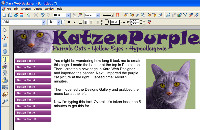
 I could. There's an option to do that from the file menu. I didn't see a special import graphic item on the menu, so I just selected "import" and pointed to the banner. That's it at the top of the page on the right.
I could. There's an option to do that from the file menu. I didn't see a special import graphic item on the menu, so I just selected "import" and pointed to the banner. That's it at the top of the page on the right.
That was pretty easy. Then I drew a text box and started typing, imported another cat picture, and selected a list of menu buttons. At some point I changed the size of the text box and noticed that depending on which handle I grabbed, I could resize the text or leave the text in its original size and change the size and shape of the containing box. At this point, I'd been working for about 5 minutes.
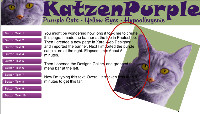
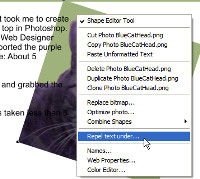 Could I rotate the photo? This would be difficult to do in Dreamweaver. I grabbed a handle and twisted (left). The photo now intrudes into my text. This is not good.
Could I rotate the photo? This would be difficult to do in Dreamweaver. I grabbed a handle and twisted (left). The photo now intrudes into my text. This is not good.
So I right-clicked the photo and noticed that I could "repel text under" the image. I selected that, but the text stayed put.
Oh, yes, it said repel text under the image. I selected the text and checked the Arrange item on the menu, thinking that I would be able to find a way to move the text backward in the stacking order so that it would be under the image.
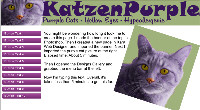
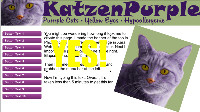 Bingo. Everything should be this easy. The text is automatically repelled by the menu buttons, so I didn't have to change anything there.
Bingo. Everything should be this easy. The text is automatically repelled by the menu buttons, so I didn't have to change anything there.
So could I put text on top of text? Again, the answer turned out to be yes. Nobody in his right mind would do what I've done with "YES" in the image at the right.
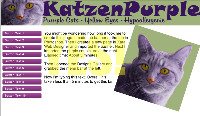
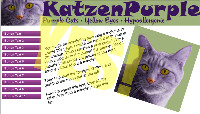 But maybe I could change the transparency of the word. I made the word larger and transparent.
But maybe I could change the transparency of the word. I made the word larger and transparent.
What if I wanted to tilt YES to the right and the rest of the text to the left? Easy.
One point that's important at this juncture is the fact that the text is still editable in Xara Web Designer. However, when I export it for use on the Web, it will no longer be text. The text will be silently converted to a graphic and will be displayed using CSS positioning, layers, and transparency. That's a tall order for an inexpensive application, but there is a downside to this approach: Search engines will no longer see the text and the text will be slightly fuzzy. Possibly more significant is the fact that this will make the page totally inaccessible to anyone who is blind and who uses a text-to-speech reader to read Web pages. This is a problem that affects only text you have rotated.
See the page I designed here.
Now for the Real Magic
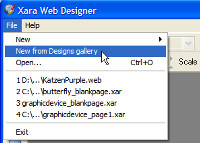
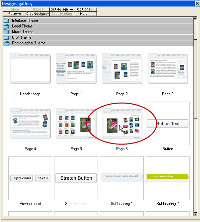 Xara Web Designer comes with dozens of templates (not the kind you'll find in Dreamweaver) and hundreds of readymade menus, banners and other elements. If you start a site with one of the existing templates, a lot of your work is already done.
Xara Web Designer comes with dozens of templates (not the kind you'll find in Dreamweaver) and hundreds of readymade menus, banners and other elements. If you start a site with one of the existing templates, a lot of your work is already done.
Here (right) is a page that shows several variations on a theme. I selected one.
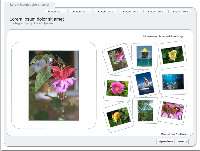 Here's my starter page.
Here's my starter page.
To replace the existing text on the page, just select the text and start typing. But how can I add a photograph?
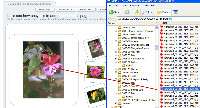 It would be nice, I thought, if I could just open the Windows Explorer, navigate to the image I want to use and drop it in the design where I want it to appear. But that would be too easy.
It would be nice, I thought, if I could just open the Windows Explorer, navigate to the image I want to use and drop it in the design where I want it to appear. But that would be too easy.
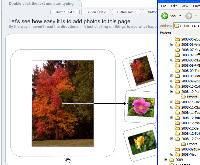 And indeed that's exactly what happened. After dropping the image, I found that I could push and pull the handles to resize it, push it around to frame it better, and even rotate it.
And indeed that's exactly what happened. After dropping the image, I found that I could push and pull the handles to resize it, push it around to frame it better, and even rotate it.
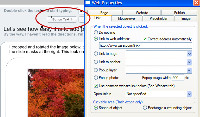 That left only the navigation bar at the top of the screen. I tried double-clicking, then selecting the button and examining the various menus. Nothing. Finally, I right-clicked and noticed the properties option.
That left only the navigation bar at the top of the screen. I tried double-clicking, then selecting the button and examining the various menus. Nothing. Finally, I right-clicked and noticed the properties option.
See the page I designed here.
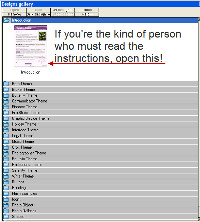 Nothing Up My Sleeves
Nothing Up My Sleeves
If you've been watching closely, you'll have noticed that my hands never left my arms during the entire demonstration. And, yes, I really did perform these feats of apparent magic without reading the instructions. But that doesn't mean they don't exist. I found them later.
The on-line instructions consist of several pages that offer tips on how to use features that you might not find if you're not looking for them. And, because Xara has a unique way of assigning colors for fill and outline, you probably will want to review that section of the document.
 Bottom Line: It's easy. It's fast. It's inexpensive. And it works.
Bottom Line: It's easy. It's fast. It's inexpensive. And it works.
Normally with a list like that, the tag line is "pick any two" but Xara Web Designer, for just $50, put an impressive amount of power in your hands.
For more information, visit the Xara website.
Finding WiFi
Do you have WiFi? If you have a notebook computer, you undoubtedly do. WiFi allows you to use the notebook computer throughout the house. Or in the back yard. But it also makes it possible for you to use the computer when you're in a hotel in New York City, Omaha, or Fargo. That's the thing about WiFi--it's everywhere. Well, maybe not everywhere, but a lot of wheres. JiWire graphically displays WiFi locations on a map and differentiates between free locations (libraries, for example) and paid sites (McDonalds's, Starbucks, and such). If you'll be traveling with your notebook computer, check JiWire before you leave.
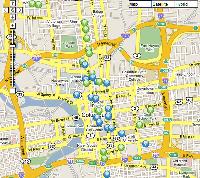
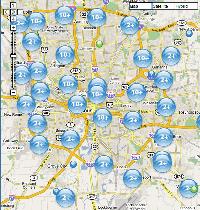 JiWire is a free service that shows WiFi resources around the planet.
JiWire is a free service that shows WiFi resources around the planet.
The image at the left shows WiFi connections in central Ohio. Smaller blue icons indicate paid WiFi locations and green icons are free locations.
The image at the right shows downtown Columbus and the short north area. There's no shortage of free WiFi selections in the area.
Click any of the images here for a full-size view.
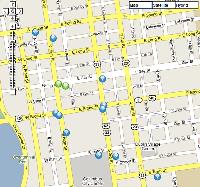
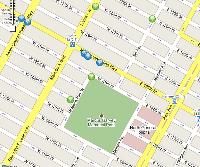 So I zoomed in a bit closer on downtown Columbus to see what was available. You'll find more paid locations than free locations, but free locations do exist. Libraries and coffee shops (except for Starbucks) often provide free service.
So I zoomed in a bit closer on downtown Columbus to see what was available. You'll find more paid locations than free locations, but free locations do exist. Libraries and coffee shops (except for Starbucks) often provide free service.
Then I tried (right) the area of Harlem where I stay when I'm in New York City. I usually stay on 120th Street near Marcus Garvey Park. The free WiFi spot on 124th is a NY Public Library branch, but I'm not sure what the location on 122nd Street is, but it appears to be the "Lenax Terrace" building, possibly an apartment or condo that provides a free service for tenants.
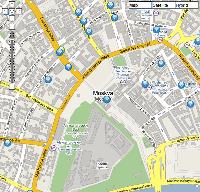 But that's not all. JiWire shows WiFi access globally. The map at the left is central Moscow. It's amusing (or maybe not) that no WiFi access exists in the Kremlin (the central green area at the bottom of the image).
But that's not all. JiWire shows WiFi access globally. The map at the left is central Moscow. It's amusing (or maybe not) that no WiFi access exists in the Kremlin (the central green area at the bottom of the image).
Outside the central city, a fair number of WiFi hot spots exist, and a few are even provided without cost.
Last summer, following a storm that knocked out power to my area for a week, I used both the city's free WiFi access and a WiFi hotspot provided by Panera Bread.
Panera, in fact, is one of my favorite companies. If you spend any time traveling, make sure you know where the closest Panera Bread is.
Besides having free WiFi, they have some excellent food.
Neat Utility: Unlocker
Have you ever tried to delete a file only to be told that Windows won't allow you to? The dialog box may tell you that the file is in use, but it probably won't tell you what application is using the file. This is more than a trivial annoyance and Windows 7 will finally resolve the problem. Windows 7 will display a "File in use" dialog if you try to delete a file that's still open in some process, but it will also name the process that has locked the file. In many cases today, you can't find that information and the only solution may be to restart the computer to release all the file locks. There's a better way, and it's free.
Cedrick Collomb says that he was so amazed by the fact that Windows XP does not give this kind of control that he decided to write a freeware tool. Apparently there was a need. It has been downloaded more than 2 million times.
Unlocker can be run with Windows so that it's always available, or you can start it only when you need it. You would need it when you try to delete a file or directory and see one of these messages:
- Cannot delete file: Access is denied
- There has been a sharing violation.
- The source or destination file may be in use.
- The file is in use by another program or user.
- Make sure the disk is not full or write-protected and that the file is not currently in use.
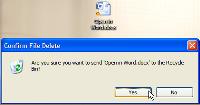 Here's a trivial example of how the utility works. I have started by creating a Word document and saving it to the desktop. The file name is "Open in Word.docx". When I try to delete the file, Windows will notice that Word has locked the file.
Here's a trivial example of how the utility works. I have started by creating a Word document and saving it to the desktop. The file name is "Open in Word.docx". When I try to delete the file, Windows will notice that Word has locked the file.
With Office 2007 and Windows XP (service pack 3), the dialog I obtain does identify the application that has locked the file. In this case, I could simply close the file in Word and then delete it. This is an addition that may be part of SP3, part of some other update, dependent on Office 2007, or some combination of those.
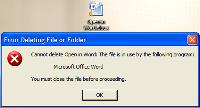 In many cases, the result will be a dialog that tells you the file is in use, but not what is using the file. In this case, with a Word document, the user will be obvious. But if you're cleaning up the temp directory and you're trying to delete a file called "Perflib_Perfdata_770.dat", the application that has locked the file will be far from obvious. (This file was created by Carbonite and I wouldn't use Unlocker to allow me to delete it.)
In many cases, the result will be a dialog that tells you the file is in use, but not what is using the file. In this case, with a Word document, the user will be obvious. But if you're cleaning up the temp directory and you're trying to delete a file called "Perflib_Perfdata_770.dat", the application that has locked the file will be far from obvious. (This file was created by Carbonite and I wouldn't use Unlocker to allow me to delete it.)
 After you clear the warning dialog, Unlocker will open, show you the process that has locked the file, and allow you to unlock the file or kill the process that has it locked. That second step is one to be taken with extreme caution. If you're not sure what a process does or what the implications of killing it are, it's best to just unlock the file. And if you're not exactly sure what the file is and you're not positive that it's safe to delete it, then you're better off not unlocking it, either.
After you clear the warning dialog, Unlocker will open, show you the process that has locked the file, and allow you to unlock the file or kill the process that has it locked. That second step is one to be taken with extreme caution. If you're not sure what a process does or what the implications of killing it are, it's best to just unlock the file. And if you're not exactly sure what the file is and you're not positive that it's safe to delete it, then you're better off not unlocking it, either.
If you don't have Unlocker running in the Tray, it's still installed as a context handler, so you can right-click any file or directory and choose Unlocker to see if a file is locked by a process and, if it is, to release the lock so that you can delete it. This is my preferred method of operation.
As with all such utilities, there is a danger that an uninformed user will create a large problem rather than solve a small problem.
But it's a handy tool to have in the kit.
 Bottom Line: Free utility allows you to delete locked files
Bottom Line: Free utility allows you to delete locked files
"Use only as directed" is the standard warning that comes with any utility. But if you know "why" you need to delete a locked file, this utility provides the "how".
For more information, visit Cedrick Collomb's website.
Note that this site is no longer available (as on 8 Nov 2013).
Short Circuits
Windows 7 Arrives on My Notebook Computer
I wanted to wait until after a Columbus Computer Society event where I needed a fully operational notebook computer with Adobe and Microsoft applications on it to install Windows 7. From what I had read, I understood that the release candidate version of Windows 7 would not be able to update an existing Windows installation, so I was prepared to format the drive and reinstall everything. When I booted to the installation DVD, the procedure told me that updating Windows XP was available only if the installer was started while Windows was running. I started Windows, then started the installer. It certainly suggested that upgrading would be possible. It wasn't.
But first it tricked me into saving files that might be important for the "upgrade". Two hours of copying files, which I never needed because updating really doesn't work. I suspect that the version as released will allow some sort of upgrade path from Windows XP. After wasting 4 hours, I was able to start the installation.
The actual installation took about 30 minutes.
So far, I've found things to like:
- I liked Vista's appearance and 7 is even better.
- 7 isn't as fast as XP, but it's a lot faster than Vista.
- Security gets in the way less than it did in Vista, although it can still be bothersome.
- It's far better (almost Mac-like) in finding and attaching to wired and wireless networks.
And things not to like:
- The moronic (there is no kinder word for this and I can think of several that would be both more rude and more accurate) decision to hide the extensions of known file types persists.
- The quick-launch area wastes a huge amount of space and I don't much care for what they've done to the System Tray (aka "Notification Area") where, by default, the AVG antivirus status icon is hidden.
- So far I haven't found a way to make the Explorer behave the way I'd like it to.
- Some things are unbearably slow. During the installation, Windows 7 created a backup of 23,900 files. I selected the directory and deleted it. The process took nearly 20 minutes!
I've not been using Windows 7 long enough to tell even a small bit of the story accurately, so I'll leave it there for now.
Broadband "Above Average" in the United States
The New York Times carried a report on broadband coverage around the world this week. The report itself was an effort by the Organization for Economic Cooperation and Development and it took into account the number of broadband subscribers per 100 residents (Denmark was at the top with about 37, Mexico was at the bottom with about 7, and the US was a little above average with 36) and price (highest cost is in the Slovak Republic, lowest is in Sweden, and those in the US pay higher than average prices).
What the article misses is the average speed of "broadband", which can range from a relatively paltry 500Kbps to 50Mbps. On average, US prices are considerably higher for the same class of service than the prices paid in Europe and Asia.
Among the nations with more widespread broadband than the United States are Iceland, Canada, France, Germany, and the UK. Among the nations with lower average monthly fees are France, Sweden, the UK, and Korea.
The OECD report does not rank every nation of the world, but only those that are members of the organization.


 The author's image: It's that photo over at the right. This explains why TechByter Worldwide was never on television, doesn't it?
The author's image: It's that photo over at the right. This explains why TechByter Worldwide was never on television, doesn't it?
